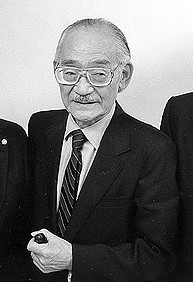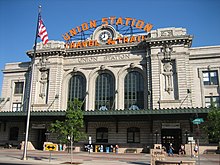Portal:Colorado
The Colorado Portal


WikiProject Colorado
You need not be either an expert or a resident.
You only need an active interest in the Centennial State.
Request an article about a Colorado topic here or volunteer here.
Colorado Events
- Wikimedia US Mountain West Spring 2024 online meeting, Tuesday, May 14, 2024, 8:00-9:00 PM MDT
- Wikimedia US Mountain West Summer 2024 online meeting, Tuesday, August 13, 2024, 8:00-9:00 PM MDT
- Wikimedia US Mountain West Autumn 2024 online meeting, Tuesday, November 12, 2024, 8:00-9:00 PM MST
Previous events:
|
|---|
Colorado events
|
Colorado Facts
- Date admitted to Union: August 1, 1876 (38th State)
- Demonym: Coloradan
- Capital: Denver
- Elected state officers:
- Governor: Jared Polis (D) (2019–)
- Lieutenant Governor: Dianne Primavera (D) (2019–)
- Secretary of State: Jena Griswold (D) (2019–)
- Treasurer: Dave Young (D) (2019–)
- Attorney General: Phil Weiser (D) (2019–)
- Colorado General Assembly:
- Colorado Senate:
- D-23 R-12 (2023–2024}
- Colorado House of Representatives:
- D-46 R-19 (2023–2024}
- Colorado Senate:
- Colorado Supreme Court:
- Brian Boatright, Chief Justice (2021–)
- Monica Márquez (2010-)
- William Hood, III (2014–)
- Richard Gabriel (2015–)
- Melissa Hart (2017–)
- Carlos Samour, Jr (2018–)
- Maria Berkenkotter (2021–)
- U.S. Senators:
- Class 2. John Hickenlooper (D) (2021–)
- Class 3. Michael Bennet (D) (2009–)
- 1. Diana DeGette (D) (1997–)
- 2. Joe Neguse (D) (2019–)
- 3. Lauren Boebert (R) (2021–2025)
- 4. vacant
- 5. Doug Lamborn (R) (2007–2025)
- 6. Jason Crow (D) (2019–)
- 7. Brittany Pettersen (D) (2023-)
- 8. Yadira Caraveo (D) (2023–)
- Total area: 104,094 square miles (269,602 km2) (eighth most extensive state)
- Highest elevation: Mount Elbert 14,440 feet (4,401.2 m) (third highest state)
- Mean elevation: 6,800 feet (2,070 m) (highest state)
- Lowest elevation: Arikaree River 3,317 feet (1,011 m) (highest state)
- Population (2020 census): 5,773,714 (21st most populous state)
- Population density: 55.47 per square mile (21.40 km−2) (39th most densely populated state)
- Number of counties: 64 counties (including two consolidated city and county governments)
- Number of municipalities: 273 municipalities, comprising 2 consolidated city and county governments, 73 cities, and 198 towns
- Time zone: MST=UTC−07, MDT=UTC−06
- USPS code: CO
- ISO 3166 code: US-CO
- Adjacent U.S. states: Wyoming, Nebraska, Kansas, Oklahoma, New Mexico, Arizona, Utah (tied for third most)
- State government website: Colorado.gov
- State tourism website: Colorado.com
State Symbols
Subcategories
U.S. Route 491 (US 491) is a north–south U.S. Highway serving the Four Corners region of the United States. It was created in 2003 as a renumbering of U.S. Route 666 (US 666). With the US 666 designation, the road was nicknamed the "Devil's Highway" because of the significance of the number 666 to many Christian denominations as the Number of the Beast. This Satanic connotation, combined with a high fatality rate along the New Mexico portion, convinced some people the highway was cursed. The problem was compounded by persistent sign theft. These factors led to two efforts to renumber the highway, first by officials in Arizona, then by those in New Mexico. There have been safety improvement projects in recent years, and fatality rates have subsequently decreased.
The highway, now a spur route of US 91 via its connection to US 191, runs through New Mexico, Colorado and Utah, as well as the tribal nations of the Navajo Nation and Ute Mountain Ute Tribe. The highway passes by two mountains considered sacred by Native Americans: Ute Mountain and an extinct volcanic core named Shiprock. Other features along the route include Mesa Verde National Park and Dove Creek, Colorado, the self-proclaimed pinto-bean capital of the world. (Full article...)Selected mountain -
Selected biography -
Commissioned into the U.S. Navy in 1949, Carpenter became a naval aviator, flying a Lockheed P-2 Neptune with Patrol Squadron 6 (VP-6) on reconnaissance and anti-submarine warfare missions along the coasts of Soviet Union and China during the Korean War and the Cold War. In 1954, he attended the U.S. Naval Test Pilot School at NAS Patuxent River, Maryland, and became a test pilot. In 1958, he was named Air Intelligence Officer of USS Hornet, which was then in dry dock at the Bremerton Navy Yard.
The following year, Carpenter was selected as one of the Mercury Seven astronauts. He was backup to Glenn during the latter's Mercury Atlas 6 orbital mission. Carpenter flew the next mission, Mercury-Atlas 7, in the spacecraft he named Aurora 7. Due to a series of malfunctions, the spacecraft landed 250 miles (400 km) downrange from its intended splashdown point, but both pilot and spacecraft were retrieved. (Full article...)
Selected article -

Minoru Yasui (安井稔, Yasui Minoru, October 19, 1916 – November 12, 1986) was an American lawyer from Oregon. Born in Hood River, Oregon, he earned both an undergraduate degree and his law degree at the University of Oregon. He was one of the few Japanese Americans after the bombing of Pearl Harbor who fought laws that directly targeted Japanese Americans or Japanese immigrants. His case was the first case to test the constitutionality of the curfews targeted at minority groups.
Yasui's case made its way to the United States Supreme Court, where his conviction for breaking curfew was affirmed. After internment during most of World War II, he moved to Denver, Colorado in 1944. In Denver, Yasui married and became a local leader in civic affairs, including leadership positions in the Japanese American Citizens League. In 1986, his criminal conviction was overturned by the federal court. (Full article...)Selected image -
A painting by Albert Bierstadt, 1877
National Parks in Colorado
The 23 national parks in Colorado:
- Amache National Historic Site
- Arapaho National Recreation Area
- Bent's Old Fort National Historic Site
- Black Canyon of the Gunnison National Park
- Browns Canyon National Monument
- Camp Hale-Continental Divide National Monument
- Canyons of the Ancients National Monument
- Chimney Rock National Monument
- Colorado National Monument
- Continental Divide National Scenic Trail
- Curecanti National Recreation Area
- Dinosaur National Monument
- Florissant Fossil Beds National Monument
- Great Sand Dunes National Park and Preserve
- Hovenweep National Monument
- Mesa Verde National Park and World Heritage Site
- Old Spanish National Historic Trail
- Pony Express National Historic Trail
- Rocky Mountain National Park
- Sand Creek Massacre National Historic Site
- Santa Fe National Historic Trail
- Yucca House National Monument
Interesting facts-

- The Lindenmeier Site in Larimer County includes a Folsom culture campsite radiocarbon dated to 8710 BCE, some 4706 years before the biblical creation.
- The French Republic concluded its sale of its colony of La Louisiane to the United States on December 20, 1803. The United States claimed the entire watershed of the Mississippi River as its territory. Spain claimed a large southwestern portion of the watershed as the trading and protective territory of its colony of Santa Fe de Nuevo México.
- On November 15, 1806, a U.S. Army reconnaissance expedition led by Captain Zebulon Pike first sighted the great summit of the Mexican Mountains that now bears his name.
- On February 26, 1807, Spanish cavalrymen arrested the Pike expedition in the San Luis Valley. The reconnaissance party was taken to Chihuahua, and then expelled from Mexico.
- William Bucknell and a party of frontier traders opened the Santa Fe Trail in 1821.
- Frontier trader William Bent operated Bent's Fort on the Santa Fe Trail from 1833 to 1849.
- The village of San Luis de la Culebra was founded on April 9, 1851, the first nonindigenous community in what would become Colorado.
- The discovery of gold by Green Russell along the South Platte River in July 1858 precipitated the Pike's Peak Gold Rush.
- The Provisional Government of the Territory of Jefferson governed the region from 1859 to 1861 without federal sanction.
- San Miguel, the original Costilla County seat, was later found to lie in New Mexico.
- Denver Union Station opened on June 1, 1881.
- Colorado became the first U.S. state to grant women the vote by popular referendum on November 7, 1893.
Did you know (auto-generated) -

- ... that following the killing of Richard Ward by a Colorado sheriff's deputy, the deputy received an award for the injuries that he allegedly sustained during the incident?
- ... that the 1976 Big Thompson River flood took place several hours before Colorado's 100th anniversary of statehood?
- ... that the No. 1–ranked 2023 Colorado Mines Orediggers, "college football's nerdiest contender", featured players with pigtails and a drawn-on blue mustache, a friar's haircut, and Harry Potter cosplay?
- ... that Yemi Mobolade is the first Black person and the first non-Republican to be elected the mayor of Colorado Springs, Colorado?
- ... that Aymara legislator Rafael Quispe's humorous style of political activism led one Bolivian parliamentarian to describe him as the "Chapulín Colorado" of the Legislative Assembly?
- ... that some members of the Daughters of the American Revolution came up with the idea to design a flag of Colorado, unaware that such a flag already existed?
- ... that "The Potato King of Colorado" survived a shipwreck, mined for gold in Australia, and helped establish an alcohol-free Methodist colony?
Related WikiProjects
Related portals
Resources
Associated Wikimedia
The following Wikimedia Foundation sister projects provide more on this subject:
-
Commons
Free media repository -
Wikibooks
Free textbooks and manuals -
Wikidata
Free knowledge base -
Wikinews
Free-content news -
Wikiquote
Collection of quotations -
Wikisource
Free-content library -
Wikiversity
Free learning tools -
Wikivoyage
Free travel guide -
Wiktionary
Dictionary and thesaurus






















